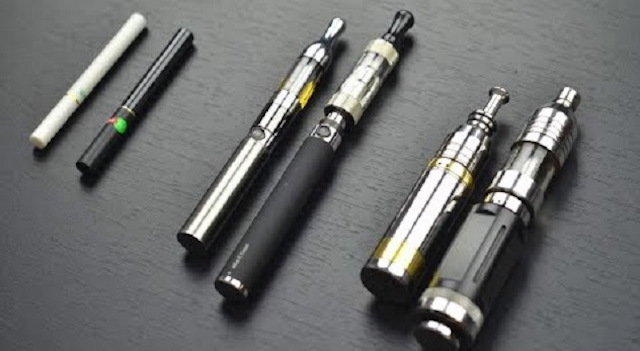
30 Jun 5 Facts That Everyone Gets Wrong About Vaping
Mike Floorwalker – Listverse
About a year ago, a couple of good friends invited me to help them run a vape shop and eventual e-juice manufacturer in my hometown (Louisville, Colorado). We in this industry believe vaping to be potentially enormously beneficial to public health, and we’ve been dismayed to see it take a pretty stern beating in the public arena. This, along with the FDA’s recent ruling in favor of strict regulation and all of the various local ordinances popping up, have prompted me to action.
5. Two Completely Different Products Are Referred To As “E-Cigs”

When most people think of an electronic cigarette, they think of the product pictured above on the far left. They look like regular (“analog”) cigarettes, you buy them at a gas station, and (if you buy Vuze or Blu, the two most popular brands) they are made by tobacco companies— Imperial Tobacco and RJ Reynolds, respectively. The cartridges in these come pre-filled, and must be replaced with new cartridges. They have very limited flavor selections, and are ostensibly a simple—perhaps healthier—replacement for cigarettes.
Yet despite their impressive sales numbers, the vast majority of those who permanently quit smoking in favor of vaping do not use them. My store doesn’t even carry them. In fact, no vape shops do—just gas stations and convenience stores.
In an actual vape shop, you’ll find products like those in the middle (commonly referred to as APVs—Advanced Personal Vaporizers—or “Vape Pens”) and on the right (“Vape Mods”). APVs (most made by Chinese companies like Innokin) contain electronics allowing the user to regulate the power level, produce a moderate amount of vapor, and are generally priced under $100. Mods (mostly made by American companies like Surefire or various small Greek and Filipino companies) are for use with user-rebuildable atomizers, can potentially produce tons of vapor, and can be quite expensive.
Users are typically introduced to vaping with the mass-market products on the left, move to the middle for a more satisfying vape (as the analog imitators are very high nicotine and low vapor), and end up on the right when they really start wanting more flavor and less nicotine (more on that shortly). This is likely why, as sales of mods or “open system” devices have increased, sales of disposables have plummeted (and why tobacco companies that make disposables would rather mods just go away altogether).
This is important because lawmakers and the media absolutely do not differentiate between the two products, yet there is a world of difference. When they claim that “nobody knows what’s in these things,” it makes me wonder exactly what things they’re talking about, since . . .
4. E-Liquid Ingredients Are Not A Mystery
My title at my company is Juicemaster General. I know, it’s an awesome title—I made it up. It means that I am responsible for every bottle of e-liquid that leaves one of our wholesale customers’ shelves, and I make 95 percent of it myself by hand. There are only four ingredients, and we did not find a single one of them on the surface of the Moon.
E-liquid begins with the main base, vegetable glycerin. We (and most other manufacturers) use certified organic VG—the glycerin doesn’t carry flavor very well, but does produce a lot of vapor. The next ingredient is propylene glycol—this is usually cited by alarmists as being a “main ingredient in antifreeze.” This is incorrect, as they’re willfully confusing it with diethylene glycol, which has actually been found in mass market e-cig products. I absolutely do not add any of that to my liquid because I do not make antifreeze.
Propylene glycol—or PG—is a main ingredient in albuterol, or asthma inhalers, and is perfectly safe to inhale when vaporized. PG is thinner than VG, and carries flavor very well—the next ingredient, flavorings, are usually suspended in PG. Flavorings are food-grade, can be natural or artificial, and are limited only by the imagination of the juice maker.
A note about these ingredients—the “we don’t know what’s in these things” arguments dissolve in the face of numerous studies like these, showing that not only do we understand completely what’s in these things, but we also have a solid understanding of their (negligible) toxicity when vaporized.
The final ingredient is pharmaceutical-grade nicotine, and all juice manufacturers make their product available in varying nicotine strengths. They range from ridiculous (up to 36 milligrams per milliliter—basically a Lucky Strike with the filter ripped off) all the way down to nothing at all. That’s right, zero. So what’s the point of selling a “tobacco product” with no nicotine, you ask?
3. Many Vapors Use Very Little To No Nicotine

You may be tempted to think I’m full of crap, but our sales figures don’t lie: In our business, e-liquid in very low to zero nicotine strength (6 mg per ml and below) outsells medium-to-high strengths (12 mg and above) by better than a two-to-one margin. Also, considering that literally every single e-liquid manufacturer offers zero-nicotine liquid—and at least one makes only that—it’s safe to say that there would be no supply if the demand did not exist. I personally had quit smoking for two years before I started vaping, and I use zero-nicotine liquid daily.
There are reasons for this. Most users start off at a high nicotine level when they are still getting off of analog cigarettes. When a beginner graduates to a device that produces more vapor, they don’t need as high a concentration of nicotine to be satisfied. Then, they may want to further “step down” (decrease the nicotine strength) once they find that high nicotine actually screws with the flavor of an e-liquid. Simply put, the less nicotine you use, the better your liquid will taste and, despite what media pundits seem to think, it turns out that even adults like things that taste good.
And I don’t mean “kid-friendly” flavors like watermelon and blueberry—although I do have a good blueberry vape if that’s your bag. One of our blends is an extremely complex mixture of oatmeal, rum, raisin, and anise. Another is an ice-blue, damn near unidentifiable tart-sweet menthol blend called Heisenberg. We’re not going for the kiddie market here.
You may be picking up that I’m referencing the many, many media assertions that we’re “targeting” children—trying to hook in kids with sweet flavors, and maybe even get them smoking. Say, did you know that . . .
2. The Vapor Is Far Less Harmful Than Cigarette Smoke

The average person has probably heard two things about the vapor produced by electronic cigarettes: either it’s perfectly harmless, or it’s worse than cigarettes, forest fires, and nuclear explosions combined. You’ve probably heard more than once that “not enough studies have been done.”
Here’s where my job as author of this article gets really easy. In case you don’t have time to read the linked studies in their entirety, allow me to quote:
A 2012 Greek study entitled Acute effects of using an electronic nicotine-delivery device on myocardial function: comparison with regular cigarettes: “Absence of combustion and different chemical composition, leading to less toxic chemicals created and absorbed . . . electronic cigarettes may be a safer alternative to tobacco cigarettes.”
A 2012 research paper entitled Levels of selected carcinogens and toxicants in vapor from electronic cigarettes: “We found that the e-cigarette vapors contained some toxic substances. The levels of the toxicants were 9–450 times lower than in cigarette smoke and were, in many cases, comparable with trace amounts found in the reference product . . . our findings are consistent with the idea that substituting tobacco cigarettes with e-cigarettes may substantially reduce exposure to selected tobacco-specific toxicants. E-cigarettes as a harm reduction strategy among smokers unwilling to quit, warrants further study.”
A 2012 study entitled Comparison of the effects of e-cigarette vapor and cigarette smoke on indoor air quality: “For all byproducts measured, electronic cigarettes produce very small exposures relative to tobacco cigarettes. The study indicates no apparent risk to human health from e-cigarette emissions based on the compounds analyzed.”
You may not have realized this had been studied so extensively, and I could link to many more. I’d like to draw attention to that last study, however—the one focusing specifically on “secondhand” vapor. The first inroads being made into legislating our industry are arguing that vaping should be restricted to the same areas as smoking as the vapor isn’t safe. Across the board in our industry, though, the feeling is that . . .
1. Vaping Does Help Smokers Quit

As our industry continues to grow, even mainstream publications are being forced to concede that there is some evidence that electronic cigarettes might be effective in helping smokers to quit. We have known this for some time. Once again, I’ll let the evidence speak for itself:
“Most participants (72 percent) were former smokers, and 76 percent were using e-cigarettes daily. At baseline, current users had been using e-cigarettes for three months, took 150 puffs per day on their e-cigarette and used refill liquids containing 16 mg/ml of nicotine, on average. Almost all the daily vapers at baseline were still vaping daily after one month (98 percent) and one year (89 percent). Of those who had been vaping daily for less than one month at baseline, 93 percent were still vaping daily after one month, and 81 percent after one year. In daily vapers, the number of puffs per day on e-cigarettes remained unchanged between baseline and one year. Among former smokers who were vaping daily at baseline, 6 percent had relapsed to smoking after one month and also 6 percent after one year.”
“In a large, international survey (emphasis mine) of current, former, or never users of e-cigarettes, 72 percent of users reported that e-cigarettes helped them to deal with cravings and withdrawal symptoms, 92 percent reported reductions in their smoking when using e-cigarettes, and only 10 percent reported that they experienced the urge to smoke tobacco cigarettes when using the e-cigarette. Moreover, of more than 2000 former smokers in this survey, 96 percent reported that the e-cigarette helped them to stop smoking.”
“In smokers not intending to quit, the use of e-cigarettes, with or without nicotine, decreased cigarette consumption and elicited enduring tobacco abstinence without causing significant side effects.”
Compare this to a truly negligible success rate for traditional nicotine replacement therapy like the patch and gum—upon which some pharmaceutical companies hang their hats—and it’s easy to see where the opposition comes from. Perhaps this is why the United States Food and Drug Administration is pushing legislation that will hand the reins of our industry over to Big Tobacco—those staunch guardians of public health—while putting companies like mine six feet under.
Meanwhile, some of the actual guardians of public health are already coming around on the issue. Many of the links I’ve used are compiled here, and this database is added to regularly—the ever-growing pile of evidence that the media is only giving you one side of the story.
This article is an excerpt from Listverse. To read in its entirety, head here.



No Comments